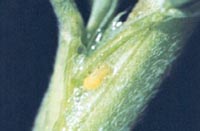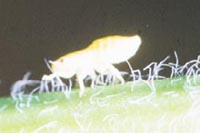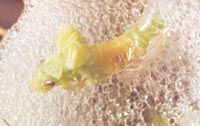Meadow Spittlebug
Philaenus spumarius

Figure 1. Meadow Spittlebug Nymph
Description
The adults are heavy-bodied, wedge-shaped
insects about a quarter of an inch long. They are usually a mottled
brown and cream, but vary from cream to almost black. They jump readily,
making an audible thump. The eggs are small, yellow-to-white, elongate
capsules laid in rows in a matrix under the leaf sheaths of grain
stubble and in similar places. The young (nymphs) are yellow to orange.
The nymphs cause the damage. They are found behind leaf sheaths, in
folded leaves, or on the leaves and stems in masses of froth or spittle
during late April, May, and early June. Both the nymphs and the adults
may be found on a wide variety of weeds and plants, but they concentrate
chiefly in alfalfa and clover fields.

Figure 2. Meadow Spittlebug
Life Cycle
There is one generation each year. The insect
overwinters in the egg stage. The eggs hatch in early to mid-April in
central Illinois, and the last two weeks in April in northern Illinois.
After the tiny nymphs hatch, they immediately start to suck sap from the
plant and form the froth in which they live. At first, they are found
in the crowns and the folded leaves of the plants; later, in large
masses of froth anywhere on the plant. From one to several nymphs may be
found in a mass of froth. The nymphs mature in June. The adults feed on
a variety of plants until late August, when they congregate in clover
and alfalfa fields to lay their eggs. Egg-laying continues through
September.
Damage
When abundant, spittlebugs stunt plant growth by
suncking the sap. They may cause losses in yield varying from slight to
25 percent or more. An average of 1 nymph per stem can decrease the
yield of dry hay by 300 or more pounds per acre. To determine the need
for treatment, count the spittlebugs on 50 to 100 stems selected
throughout the field.

Figure 3. Meadow Spittlebug
on Mass of Froth
Control
Chemical control is usually not profitable if the
number of spittlebug nymphs averages fewer than I per stem. When the
average is 1 or more nymphs per stem, control will be profitable if you
need the hay.